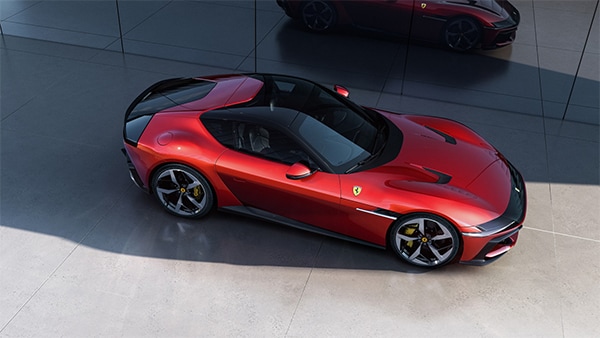
There are cars, and then there are Ferraris—machines that ignite the senses before they even turn a wheel. For decades, Ferrari has produced more than just fast cars. It has created rolling sculptures—masterpieces of engineering wrapped in flowing forms that stir the soul.
Every curve, vent, and crease on a Ferrari tells a story. And it’s no accident. Behind the prancing horse is a design philosophy rooted in beauty, performance, and emotion. This is what separates Ferrari from everything else on the road.
Here’s why every Ferrari—past, present, and future—is a work of art.
Form Follows Emotion
Ferrari’s design approach has always transcended pure functionality. Yes, the cars are aerodynamic. Yes, they’re engineered to perform at the highest level. But the driving goal is something more visceral: emotion.
Each Ferrari is designed not just to be fast, but to feel fast. Even at rest, a Ferrari should suggest motion, tension, and drama. The goal isn’t simply to cut through the air—it’s to capture your attention and imagination.
As Enzo Ferrari famously said,
“A Ferrari is a dream. For most people it will remain a dream. For those lucky few, it becomes reality.”
Pininfarina, Manzoni, and the Legacy of Italian Design
For decades, Ferrari partnered with legendary design house Pininfarina, shaping icons like the 250 GTO, Testarossa, and F40. The Pininfarina era defined the elegant, flowing aesthetic of classic Ferrari.
In recent years, Ferrari has moved design in-house under the creative leadership of Flavio Manzoni, head of Ferrari Centro Stile. Manzoni, an architect by training, brings a sculptural and futuristic eye to modern Ferraris. Under his guidance, cars like the 812 Superfast, Roma, SF90 Stradale, and Daytona SP3 have redefined what modern automotive beauty looks like—fusing heritage with innovation.
Design Driven by Purpose
While a Ferrari’s beauty is undeniable, its design is never just for show. Every line is sculpted by both airflow and artistry. Aero elements are often hidden in plain sight—integrated into the bodywork so elegantly you might miss them.
Take the Ferrari 296 GTB: its active rear spoiler is concealed until deployed, maintaining a clean profile while delivering downforce when needed. Or the Roma, whose minimalist lines conceal advanced cooling ducts and underbody aero.
Ferrari has mastered the art of making performance invisible, resulting in a purity of form rarely seen in modern cars.
Signature Styling Cues That Define the Brand
Across generations, certain Ferrari design elements have become iconic:
- Long, sculpted hoods: A nod to front-engined V12 legends like the Daytona and 812 Superfast.
- Short rear overhangs: Enhancing weight distribution and giving the car a poised, athletic stance.
- Quad taillights: A recurring theme from the 308 to the F8 Tributo.
- Curved side air intakes: Functional art, especially on mid-engine models.
- The Prancing Horse emblem: Always placed with precision, often against Rosso Corsa red or Nero black.
These design touches don’t just hint at Ferrari’s past—they reinforce its unmistakable identity.
Bespoke Beauty: Tailor Made & Icona Series
For those who want to go beyond the standard canvas, Ferrari offers the Tailor Made program, allowing clients to work directly with designers to create one-of-a-kind specifications. From unique paint colors and heritage racing liveries to custom interior materials and finishes, these cars are built like fine art—commissioned, not configured.
The Icona Series—featuring the Monza SP1/SP2 and Daytona SP3—further exemplifies Ferrari’s fusion of past and future. These limited-run masterpieces pay homage to classic models, reimagined through modern design language.
Ferraris Belong in Galleries (and on the Big Screen)
It’s no surprise that Ferrari has become a staple in pop culture and fine art. The Ferrari 250 GTO is considered by many to be the most beautiful car ever made—and one of the most valuable, fetching over $70 million at auction.
Ferraris appear in everything from art exhibitions to films, not because they’re status symbols, but because they evoke emotion, history, and craftsmanship. They are mechanical works of art, as worthy of display as any sculpture in the Louvre.
Final Thought: Beauty That Moves You—Literally
A Ferrari is more than the sum of its speed, sound, and stats. It’s the feeling you get when you look at it, even before you drive it. It’s the perfect union of engineering and emotion, of form and function.
That’s why every Ferrari is a work of art—not just to admire, but to drive.
Looking to add a piece of Ferrari artistry to your garage? Explore our current inventory or speak with a Ferrari specialist at Boardwalk Ferrari today. Whether you’re chasing a modern masterpiece or a timeless classic, we’ll help you find a Prancing Horse that speaks to you.